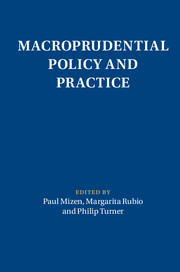Book contents
- Macroprudential Policy and Practice
- Macroeconomic Policy Making
- Macroprudential Policy and Practice
- Copyright page
- Contents
- Contributors
- Introduction
- 1 The Macroeconomics of Macroprudential Policies
- 2 A Liquidity-Based Approach to Macroprudential Policy*
- 3 Financial Intermediation and Monetary and Macroprudential Policies
- 4 The New Art of Central Banking
- 5 The Macroprudential Countercyclical Capital Buffer in Basel III
- 6 On the Use of Monetary and Macroprudential Policies for Small Open Economies
- 7 Capital Flows and Macroprudential Policy
- 8 Macroprudential Policy in a Globalised World
- 9 Systemic Risk of European Banks
- 10 Macroprudential Tools of Systemic Risk Analysis
- 11 When Is Macroprudential Policy Effective?
- 12 Macroprudential Policy
- Index
- References
3 - Financial Intermediation and Monetary and Macroprudential Policies
Published online by Cambridge University Press: 09 August 2018
- Macroprudential Policy and Practice
- Macroeconomic Policy Making
- Macroprudential Policy and Practice
- Copyright page
- Contents
- Contributors
- Introduction
- 1 The Macroeconomics of Macroprudential Policies
- 2 A Liquidity-Based Approach to Macroprudential Policy*
- 3 Financial Intermediation and Monetary and Macroprudential Policies
- 4 The New Art of Central Banking
- 5 The Macroprudential Countercyclical Capital Buffer in Basel III
- 6 On the Use of Monetary and Macroprudential Policies for Small Open Economies
- 7 Capital Flows and Macroprudential Policy
- 8 Macroprudential Policy in a Globalised World
- 9 Systemic Risk of European Banks
- 10 Macroprudential Tools of Systemic Risk Analysis
- 11 When Is Macroprudential Policy Effective?
- 12 Macroprudential Policy
- Index
- References
Summary
New-Keynesian Dynamic Stochastic General Equilibrium (NK-DSGE) models have been severely criticised after the outbreak of the global financial crisis in 2008. Intensive research is underway in both academia and central banks to incorporate a more realistic modelling of financial intermediation and a role for macroprudential policy. Given the technical and computational difficulties arising from modelling systemic risk, it may take some time before economists develop new models that allow a comprehensive and integrated approach to the study of the linkages between financial intermediation and the real economy and the role of policies to promote and preserve financial stability. In the meantime, existing models can be used for the analysis of monetary and macroprudential policy and their interaction.
- Type
- Chapter
- Information
- Macroprudential Policy and Practice , pp. 61 - 86Publisher: Cambridge University PressPrint publication year: 2018



